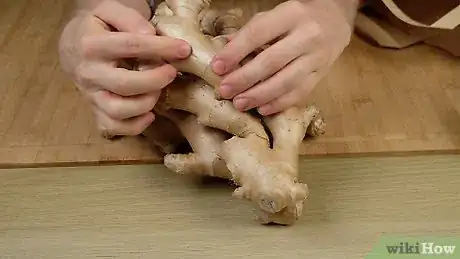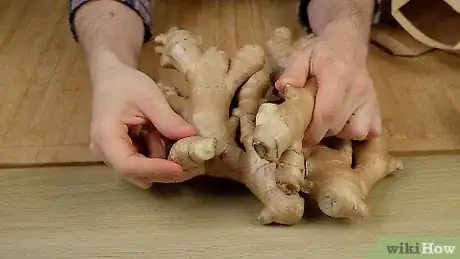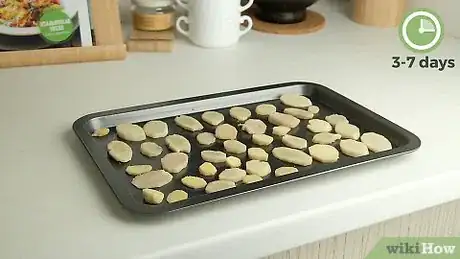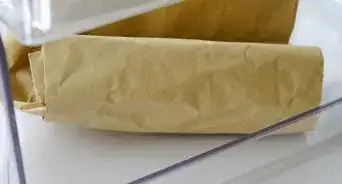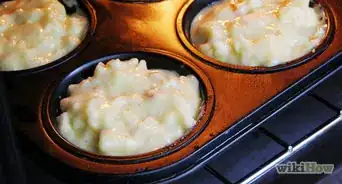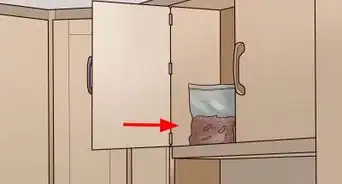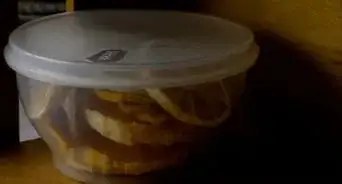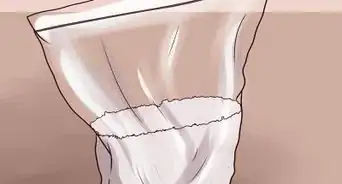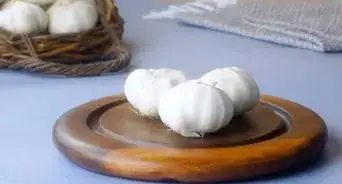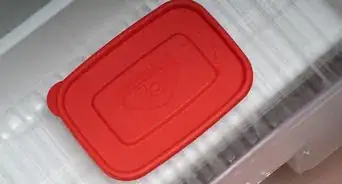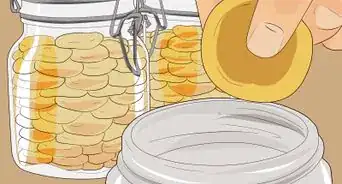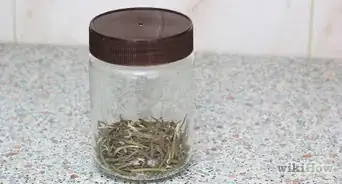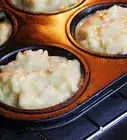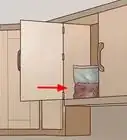This article was co-authored by wikiHow staff writer, Hannah Madden. Hannah Madden is a writer, editor, and artist currently living in Portland, Oregon. In 2018, she graduated from Portland State University with a B.S. in Environmental Studies. Hannah enjoys writing articles about conservation, sustainability, and eco-friendly products. When she isn’t writing, you can find Hannah working on hand embroidery projects and listening to music.
There are 8 references cited in this article, which can be found at the bottom of the page.
The wikiHow Video Team also followed the article's instructions and verified that they work.
This article has been viewed 53,652 times.
Learn more...
Ginger is a root that is used in natural medicines, recipes, and spice blends. It can be used to flavor a dish, settle an upset stomach, or even be brewed into a tea. Dried ginger is easy to store and keep to use in your household for months at a time. Whether you dry your ginger in the sun, in your oven, or in a food dehydrator, you can make dried ginger easily and with a little bit of patience.
Steps
Buying and Peeling Your Ginger
-
1Snap a small piece from the root to test for freshness. If the ginger snaps easily and does not have a lot of fibers, it is fresh. If it is hard to snap or has a lot of fibers connecting it to the root, it has more moisture in it than usual, and it will be harder to dry.[1]
- Ginger can be found at most grocery stores, but if the ginger there isn’t fresh, try looking for a farmer’s market or produce market in your area.
-
2Smell the ginger for a spicy and rich scent. Fresh ginger will smell sharp and have a strong scent, even with the skin still on. If the scent is dull or subtle, the ginger is probably not fresh and might be harder to dry or not have as bold of a flavor.[2]Advertisement
-
3Press your nail into the skin to make sure it is thin. Ginger is much easier to dry when the skin is thin because it holds in less moisture. The skin of your ginger should be shiny and you should be able to mark it with your nail. If the skin is too thick, it will be harder to mark and will look duller.
-
4Rinse the ginger in cold water to get rid of dirt on the skin. Ginger is a root, which means that it was covered in dirt before being dug up. There might still be some dirt left on the skin of your ginger, but you can run it under cold water for a few seconds to wash it off. The ginger doesn’t have to be perfectly clean, since you will be taking the skin off.[3]
-
5Peel the skin off with a potato peeler. Ginger skin is tough and doesn’t taste very good. Use a potato peeler to cut the skin off so that you are left with the softer, more flavorful part of the ginger root. You don’t need to peel very far down into the ginger, you just need to slice the thin layer of skin off.[4]
- You can buy a potato peeler at most grocery and home goods stores.
- If you don’t have a potato peeler, you can use a sharp knife to carefully cut the skin off of your ginger.
-
6Cut your ginger into slices that are about 1⁄8 inch (0.0032 m) thick. The thinner your ginger pieces are, the faster they will dry. You can use either a sharp knife or a cheese grater to get your slices paper-thin. If you use a cheese grater, your slices will be smaller and may be easier to grind or chop later.[5]
Drying in the Sun
-
1Place the ginger pieces on a baking tray, making sure they don’t overlap. Spread your pieces of ginger on a baking tray that is large enough to ensure that none of the pieces overlap. If your ginger pieces are touching, they will probably dry slower.[6]
- You can line your baking tray with parchment paper for easy removal of the ginger later.
-
2Put your tray in an area that gets 8 hours of sun a day. The more sun that your ginger pieces get, the faster they will dry. Find an area in your house that gets at least 8 hours of sun a day and place your baking tray in a place that it can stay for a few days.[7]
- Window sills are an ideal place for drying ginger.
- If you live in a climate with low humidity, you can leave your ginger outside to sit in the sun instead, but this could attract small pests, like aphids.
-
3Leave the tray in the sun for 3 days to 1 week. Depending on how much sun your ginger gets and how much humidity is in the air, sun drying can take anywhere from 3 days to 1 week. Ginger will snap when it is fully dry. Check your ginger daily to see if it is dry or if it needs more time in the sun.[8]
-
4Store your dried ginger in an airtight container for 5 to 6 months. After your ginger is dry, you can transfer it to an airtight container and store it in a cool, dry place. You can keep dried ginger for 5 to 6 months before using it.[9]
Using a Food Dehydrator
-
1Lay ginger slices on your dehydrating tray, making sure the pieces don’t overlap. Your ginger will dehydrate faster if the pieces are not touching each other. Lay your ginger on your dehydrating tray in a single layer so that they are not touching each other. Depending on how much ginger you are drying, you might have to do two rounds of dehydrating to make sure that all the pieces have enough room.[10]
- Make sure your ginger pieces are large enough that they won’t fall through the holes in the tray.
-
2Dehydrate your ginger at 135 °F (57 °C) for 3-4 hours. You can check your ginger after 3 hours to see if it needs more time. When your ginger is dry, it will snap easily and look much smaller than it did originally. Your ginger pieces may need more time to dehydrate depending on how big they are and how humid your climate is.[11]
- Try not to over-dehydrate your ginger. Over-dehydrating will give your dried ginger a burnt taste. If your ginger changes colors or crumbles, it might be over-dehydrated.
-
3Store it in an airtight container or plastic bag for 5 to 6 months. Once your ginger is dry, you can put it in an airtight container or a plastic bag and keep it in a cool, dry place. Be sure to use your dried ginger within 5 to 6 months of drying it.[12]
Baking in the Oven
-
1Spread the ginger on a baking tray, making sure they don’t overlap. Your ginger will dry faster if none of the pieces are touching. Spread your ginger out on a baking tray and give each piece enough room to sit without touching any others. Depending on how much ginger you have to dry, you may have to use 2 baking trays.[13]
- You can line your baking tray to help with removal later, but you don’t have to.
-
2Bake in the oven at 150 °F (66 °C) for 1 ½ to 2 hours. Your oven should be on a very low temperature so that the ginger doesn’t burn. Check the ginger every half an hour to make sure it isn’t getting overly dry or burning. Dried ginger should snap easily and be smaller in size than when it was not dry.[14]
- Your ginger can burn in the oven if it is in there for too long. If your ginger getting darker or smoking, take it out of the oven right away.
-
3Cool your ginger for 1 hour. Before you use or store your dried ginger, make sure that it is completely cool. Set your baking tray on a kitchen counter to cool down for 1 hour before you take the pieces off.[15]
-
4Store it in an airtight container or plastic bag for 5 to 6 months. Once your ginger is cool, you can take it off of your baking tray and put it in an airtight container or plastic bag. Store your ginger in a cool, dry place and use it within 6 months of drying it.[16]
Things You’ll Need
Drying in the Sun
- 1 large baking tray
- 1 sharp knife
- 1 potato peeler or knife
Using a Food Dehydrator
- 1 food dehydrator
- 1 sharp knife
- 1 potato peeler or knife
Baking in the Oven
- 1 large baking tray
- 1 sharp knife
- 1 potato peeler or knife
References
- ↑ https://www.thekitchn.com/3-tips-for-buying-and-storing-fresh-ginger-228479
- ↑ https://www.thekitchn.com/3-tips-for-buying-and-storing-fresh-ginger-228479
- ↑ https://healthfully.com/232697-how-to-dry-ginger-root.html
- ↑ https://www.simplyrecipes.com/recipes/how_to_peel_and_chop_ginger/
- ↑ https://healthfully.com/232697-how-to-dry-ginger-root.html
- ↑ https://healthfully.com/232697-how-to-dry-ginger-root.html
- ↑ https://healthfully.com/232697-how-to-dry-ginger-root.html
- ↑ https://healthfully.com/232697-how-to-dry-ginger-root.html
- ↑ https://www.thekitchn.com/3-tips-for-buying-and-storing-fresh-ginger-228479
- ↑ https://www.youtube.com/watch?v=3I8vWJGmvG4&feature=youtu.be&t=33
- ↑ https://hellocreativefamily.com/back-basics-dehydrate-ginger/
- ↑ https://www.thekitchn.com/3-tips-for-buying-and-storing-fresh-ginger-228479
- ↑ https://www.youtube.com/watch?v=6-7qiplF9tM&feature=youtu.be&t=72
- ↑ https://www.youtube.com/watch?v=6-7qiplF9tM&feature=youtu.be&t=186
- ↑ https://www.youtube.com/watch?v=6-7qiplF9tM&feature=youtu.be&t=186
- ↑ https://www.eatbydate.com/other/spice-menu/how-long-does-ginger-last-shelf-life/
